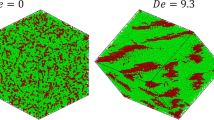Summary
A detailed description of several phenomena observed during crystallization in a stirred solution of linear polyethylene is presented. It is found that simple shear flow is incapable of accelerating the formation of primary nuclei at elevated temperatures in 5% xylene solution of linear polyethylene (Marlex). The onset of fibrillar crystal formation is noted when the stirrer speed of the inner cylinder of aCouette instrument exceeds a minimum value which corresponds to the onset ofTaylor vortices. Closed loops of fibrillar crystals occurring periodically around the stirrer, revolve in orbits which coincide with the centers of theTaylor vortices. Turbulent flow seems to be most effective in inducing fibrillar crystallization and a maximum crystallization temperature of 112°C was achieved with the 5% xylene solution of Marlex. A mechanism is proposed for the formation of primary nuclei of bundlelike type which is based upon orientation and deformation of aggregates in regions of elongational flow between the vortices. Solutions of high molecular weight polyethylene (M w=1.5×106) exhibit a pronouncedWeissenberg effect prior to the appearance of the first fibers. Normal stresses lower the rate of stirring inCouette flow at which vortices occur. This may account for the observed fibrillar crystallization of the high molecular weight polyethylene at stirrer speeds which in case ofNewtonian fluids give rise to laminar flow according to theTaylor criterion. Settlement of the fibrous network on the stirrer results from secondary flow.
Zusammenfassung
Es werden verschiedene, während der Kristallisation in einer gerührten Lösung von linearem Polyäthylen wahrgenommene Erscheinungen eingehend beschrieben. Es zeigt sich, daß eine einfache Strömung unter Scherung die Bildung von Primärkeimen bei gesteigerten Temperaturen in einer 5% igen Xylollösung von linearem Polyäthylen (Marlex) nicht zu beschleunigen vermag. Es wird festgestellt, daß die Bildung von Faserkristallen einsetzt, wenn die Rührgeschwindigkeit des Innenzylinders einesCouette-Gerätes einen der Entstehung derTaylorschen Wirbel entsprechenden Minimalwert übersteigt. Geschlossene Ringe von Faserkristallen, welche sich periodisch um den Rührer bilden, rotieren in Bahnen, welche durch die Mittelpunkte derTaylor-Wirbel gehen. Anscheinend ist eine turbulente Strömung das zweckmäßigste Mittel zum Hervorrufen einer Faserkristallisation; es wird hiermit in der 5% igen Xylollösung von Marlex eine maximale Kristallisationstemperatur von 112°C erreicht. Ferner wird ein Mechanismus zur Bildung von Primärkeimen vom garbenförmigen Typ vorgeschlagen auf Basis von Orientierung und Deformation von Aggregaten in den Geschwindigkeitsfeldern mit parallelen Gradienten zwischen den Wirbeln. Lösungen von Polyäthylen mit hohem Molekulargewicht (Mw=1,5×106) zeigen einen ausgeprägtenWeissenberg-Effekt, der dem Auftreten der ersten Fasern vorangeht. Normalspannungen erniedrigen den kritischen Wert der Rührgeschwindigkeit, bei der in einemCouette-Gerät eine Wirbelbildung auftritt. Dies dürfte eine Erklärung bieten für die beobachtete Faserkristallisation des hochmolekularen Polyäthylens bei Rührgeschwindigkeiten, welche im Falle derNewtonschen Flüssigkeiten zu einer demTaylorschen Kriterium entsprechenden Laminarströmung führen. Die Ablagerung des Fasernetzes auf dem Rührer ist auf Sekundärströmung zurückzuführen.
Similar content being viewed by others
References
Pennings, A. J. Symposium on Macromolecular Chemistry, Prague (1965). preprint 216, J. Polymer Sci. Part C,16, 1799 (1967).
Pennings, A. J. andA. M. Kiel, Kolloid-Z. u. Z. Polymere,205, 160 (1965).
Pennings, A. J., Crystal Growth, Proc. Int. Conf. on Crystal Growth, Boston (Oxford 1966), pp. 389–393.
Pennings, A. J., in: Characterization of Macromolecular Structure, Proc. of Conf. April (1967), Warrenton, U.S.A. (Washington, D.C. 1968).
Keller, A. andM. N. Machin, J. Macromol. Sci. (Phys.),B1 (1), 41 (1967).
Williamson, R. B. andW. F. Busse, J. Appl. Phys.38, 4187 (1967).
Wikjord, A. G. andR. St. John Manley, J. Macromol. Sci. (Phys.)B 2 (3), 501 (1968).
Keller, A. andF. M. Willmouth, Makromol. Chem.121, 42 (1969).
Forgaes, O. L. andS. G. Mason, J. Colloid Sci.14, 473 (1959).
Taylor, G. I., Phil. Trans.223 A, 289 (1923).
Tillmann, W., Z. Angew. Phys.13, 468 (1961).
Schlichting, H., Handb. Physik. Bd. VIII, 367 (1959).
Coles, D., J. Fluid Mech.21, 385 (1965).
Tietjens, O., Strömungslehre, p. 451 (Berlin-Heidelberg-Göttingen 1960).
Prandtl, L., “Führer durch die Strömungslehre”, Braunschweig (1965), p. 174.
Taylor, G. I., Proc. Royal Soc.157, 564 (1936).
Giesekus, H., Proc. 4th Inter. Congress on Rheol., Providence (1963). Part1, p. 249 (Interscience Publ. (1965)).
Giesekus, H., Rheol. Acta5, 239 (1966).
Kawai, T., T. Matsumoto, M. Kato andH. Maeda, Kolloid-Z. u. Z. Polymere222 1 (1968).
Reneker, D. H., private communication.
Graessley, W. W., J. Chem. Phys.43, 2696 (1965);47, 1942 (1967).
Bueche, F., J. Chem. Phys.48, 4781 (1968).
Schurz, J., Kolloid-Z. u. Z. Polymere227, 72 (1967).
Porter, R. S. andJ. F. Johnson, Trans. Soc. Rheol.11, 259 (1967).
Peterlin, A., Polymer Letters4, 287 (1966).
Metzner, A. B., E. A. Uebler, andC. F. Chan Man Fong, A. I. Ch. E. J.15, 750 (1969).
Tsvetkov, V. N., J. Rubber Chem. Techn.36, 337 (1963).
Takserman-Krozer, R. andA. Ziabicki, J. Polymer Sci.A1, 2487 (1963).
Metzner, A. B., (to be published).
Metzner, A. B. andM. Graham Park, J. Fluid Mech.20, 291 (1964).
Fabula, A. G., J. L. Lumley, andU. D. Taylor, Some interpretations of the Toms effect. Proc. Rheol. Conf. Syracuse University (1965).
Ziabicki, A., in: Man-Made Fibers: Science and Technology p. 73. Volume I edited byH. F. Mark, S. M. Atlas, andE. Cernia (London-New York 1967).
Ziabicki, A. andK. Kedzierska, J. Appl. Polymer Sci.2, 14 (1959).
Frenkel, S. Ya. andB. M. Ginzburg, Probl. Fiz.-Khim Mekh. Voloknistykh Poristykh Dispersnykh. Strukt. Mater., Mater. Konf., Riga (1965).
Van der Vegt, A. K. andP. P. A. Smit, Soc. Chem. Ind. (London) Monogr.11026, 313 (1967).
Blackadder, D. A. andH. M. Schleinitz, Nature200, 778 (1963).
Peterlin, A., Polymer8, 21 (1967).
Author information
Authors and Affiliations
Additional information
With 8 figures in 10 details and 1 table
Rights and permissions
About this article
Cite this article
Pennings, A.J., van der Mark, J.M.A.A. & Booij, H.C. Hydrodynamically induced crystallization of polymers from solution. Kolloid-Z.u.Z.Polymere 236, 99–111 (1970). https://doi.org/10.1007/BF02086621
Received:
Issue Date:
DOI: https://doi.org/10.1007/BF02086621




